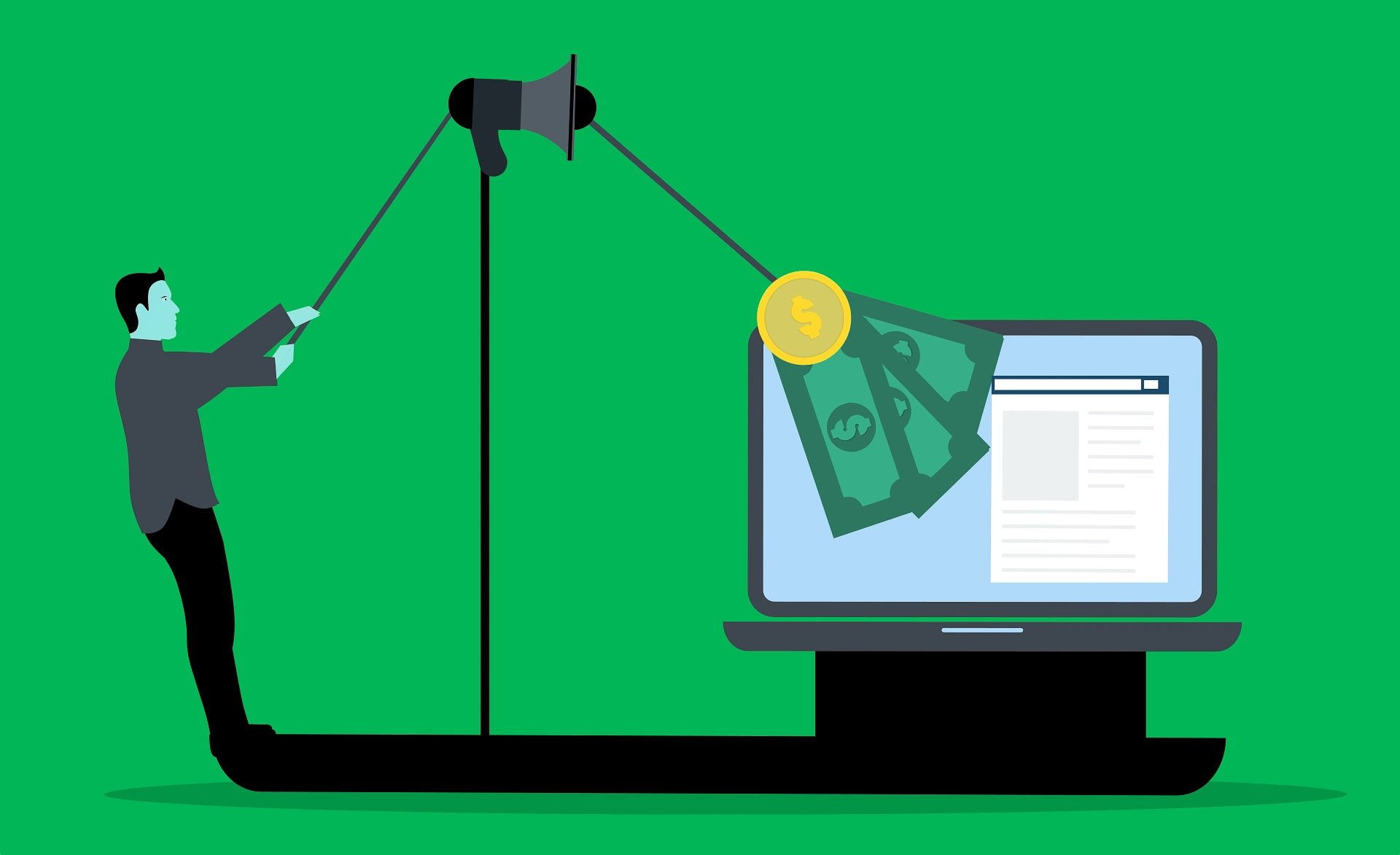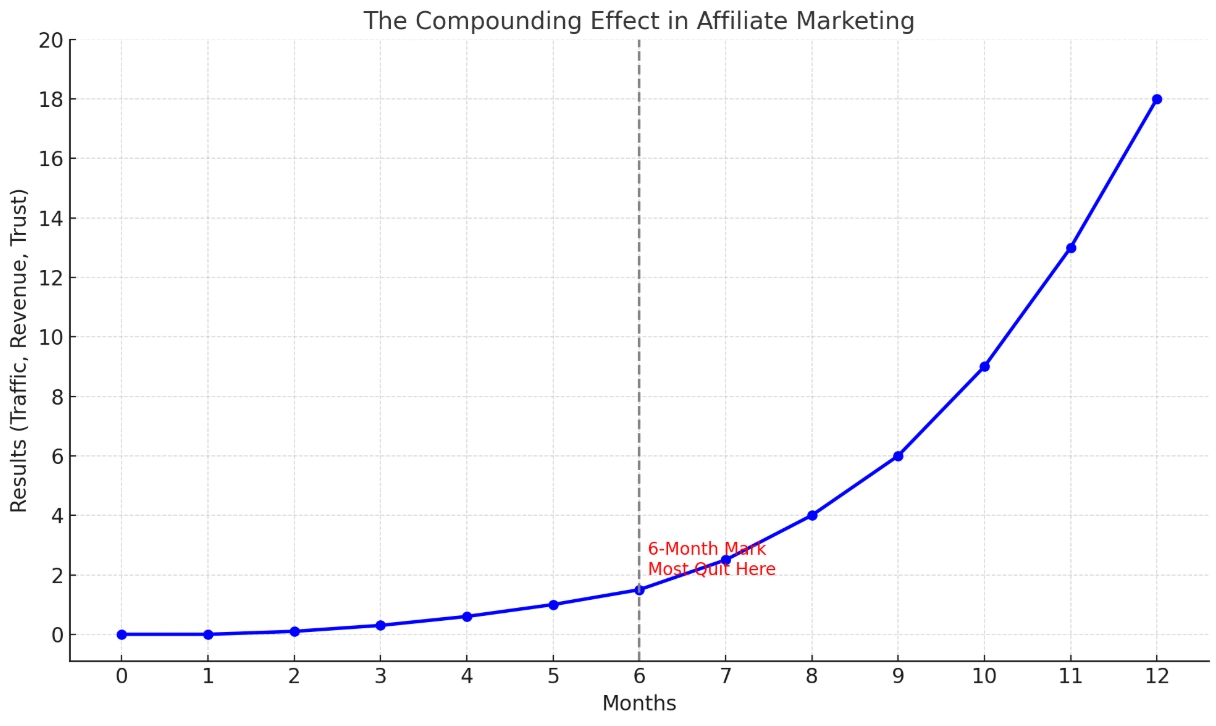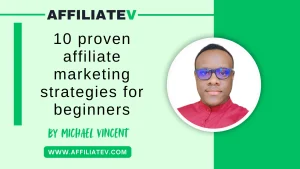The Compounding Effect in Affiliate Marketing: Why Your First 6 Months Feel Slow (But Matter Most)
Learn how the compounding effect in affiliate marketing builds passive income, especially after the first 6 months of slow growth.

Most affiliates quit too soon. That’s not just something people say. It’s the truth. You’ll see folks posting like crazy in the first month, maybe two. Then nothing. They stop because there’s no traction. No sales. No feedback. It feels like talking to a wall.
I’ve seen it happen over and over. And I’ve done it myself. One site I built years ago had ten blog posts, decent content, and a few solid keywords. I gave up on it after four months of silence. Six months later, traffic started climbing without me doing anything. That’s when I learned how this game really works.
The compounding effect explains it.
In simple terms, compounding means small actions build on each other over time. In the beginning, it feels like nothing’s moving. But what you’re doing is stacking effort. And that effort gains momentum the longer it sits and works in the background.
And as I always say, it’s like rolling a snowball. The start feels pointless. But the further you go, the faster it grows.
Now here’s where most affiliates miss the point.
The early stage—those quiet months when nothing seems to happen—is where everything starts. You’re publishing posts, building backlinks, optimizing pages, testing content, figuring out your voice, and building trust. You don’t see results yet. But those things are setting you up for everything that comes later.
Google doesn’t rank you overnight. Pinterest doesn’t blow up your first pin. People don’t click your links just because you posted once. That’s not failure. That’s delay. And delay is built into how this model works.
So when you’re six months in and still seeing crickets? That’s not the end. That’s your foundation. It means the machine is warming up. And if you stay in the game, all those “wasted” posts from Months 1, 2, and 3 will start pulling traffic in Months 7, 8, 9…
Here’s the hard truth: those dry months are your investment phase. And that’s when it matters most.
The people who win in affiliate marketing aren’t just good marketers. They’re the ones who don’t quit before the snowball gets rolling.
Key Takeaways
- The compounding effect in affiliate marketing means early work pays off later with steady growth.
- The first 6 months often feel slow, but they lay the foundation for long-term income.
- Content, backlinks, and trust build up over time—results aren’t instant.
- Most affiliates quit too soon, missing the point where momentum kicks in.
- Consistency beats quick wins. Focus on quality and stay in the game.
- Passive income starts flowing once your content ranks and traffic grows on autopilot.
- Patience, smart strategy, and time are your biggest assets in affiliate success.
What Is the Compounding Effect in Affiliate Marketing?
As I mentioned above, the compounding effect is when small, consistent actions build on each other and grow more powerful over time. In affiliate marketing, this means the work you do today—writing a blog post, adding an internal link, publishing a pin—keeps working in the background long after you’ve moved on.
It’s like compound interest. At first, the growth feels slow. You put in effort, and the return is small or invisible. But over time, the results stack up. What felt like a waste in month one starts to make sense in month six or more.
When you create content, you’re giving Google something to index. When you build links, you’re telling search engines your site has value. When you post consistently, people start trusting your voice. None of that happens instantly, but it all adds up.
That’s the power of compounding. One post doesn’t do much. Ten posts start to get noticed. Fifty can bring in traffic every day. The same goes for backlinks, videos, and email signups. The early steps don’t just support the business—they become the engine that drives it later.
It’s not just about working hard. It’s about sticking around long enough for your work to start working for you.
Why the First 6 Months Feel So Damn Slow
The early months of affiliate marketing are brutally quiet. You’re putting in hours, maybe even money, and getting nothing back. It’s not your fault. It’s just how this works in the beginning.
Here’s why it feels so slow:
1. You have no SEO traction yet: Google doesn’t trust new sites. Even with great content, it can take three to six months before your posts start ranking for anything worth clicking. That delay kills motivation.
2. Your traffic is low: With no rankings, no audience, and no viral content yet, you’re lucky to get a few visitors a day. You check your analytics and it’s flat. Some days it’s zero. That hits hard.
3. You don’t have enough content: Ten posts isn’t enough to build authority. Twenty is barely a start. Until your site becomes a real resource, it’s not going to pull in consistent traffic or clicks.
4. There’s no trust with your audience: If you’re building an email list or a following, people still don’t know who you are. You haven’t built a voice or rhythm yet, and no one buys from someone they don’t trust.
5. All of that adds up to serious doubt: You start questioning if you picked the right niche. If affiliate marketing is even worth it. You feel burnout. You look at your dashboard, and the commissions are still at zero.
It’s frustrating because you’re doing the work, and there’s no feedback loop. No clicks. No conversions. Just silence.
That’s when most people quit. Not because they failed—but because they couldn’t see the compound growth starting to take shape.
But that slow start? That’s normal. And it’s temporary.
The Hidden Work That Starts Paying Off Later
What makes affiliate marketing hard in the beginning is that everything feels invisible. But under the surface, your work is stacking. You won’t notice it at first—but it’s building. Quietly.
Every blog post adds weight to your site. The first five posts might not get traffic. But by post fifteen or twenty, things start to shift. Internal links connect topics. Old posts age. Keywords mature. Google starts paying attention.
Backlinks show up when you least expect. Sometimes a post you wrote months ago gets shared. Or someone links to it in a roundup. The more useful your content is, the more backlinks come in naturally, even without outreach.
Your email list grows one signup at a time. You might start with zero. Then two. Then ten. But every person who joins gets familiar with your voice. Over time, that list becomes a traffic source, a feedback loop, and a revenue stream.
Search rankings move slow, then jump. You publish a post. Nothing happens. Then, weeks later, it hits page 3. A few backlinks later, it lands on page 1. It’s not magic. It’s just time and consistency. Google needs to see that your site isn’t going anywhere.
If you were to plot this on a graph, it wouldn’t be a straight line. It would look flat…flat…flat…then suddenly—upward.
Like this…

That’s what compounding looks like.
All those quiet tasks you did early on? They’re working behind the scenes. And when they start to pay off, they pay off big.
Real Examples of Compounding Results Over Time
Here’s what the compounding effect actually looks like in real life—not theory.
I once launched a niche blog built around reviews of digital marketing tools. I went all in: 3 posts per week, basic SEO, manual Pinterest pins, and a small email opt-in. For the first six months, nothing moved. No traffic. No income. I nearly scrapped the project.
But I kept going.
By month seven, I noticed a few posts hit page 2. Email signups started trickling in. I wasn’t doing anything new—just staying consistent. By month nine, one of my posts landed on page one for a product keyword. Clicks followed. Then sales. One blog post started pulling in $100+ per month, on autopilot.
That single post? It was published back in month three.
The same thing happened with an email sequence I built in month four. No one read it for months. Then once my list hit 300+ subs, that same sequence began generating affiliate sales weekly—without me touching it.
Here’s a basic timeline of how that looked:
| Month | Work Done | Results Seen |
|---|---|---|
| 1 | Site setup, 3 posts, Pinterest setup | Zero traffic, no income |
| 2 | 6 more posts, email opt-in created | Still no movement |
| 3 | 3 more posts, light outreach | 1 backlink, a few clicks |
| 4 | Created lead magnet + email sequence | List at 22 subs, no sales |
| 5 | 5 more posts, internal links | Ranking on page 3 for a few keywords |
| 6 | SEO audit, updated older posts | Traffic steady at ~20 visits/day |
| 7 | No new content, added 2 backlinks | Post hits page 2 |
| 8 | Old content resurfaces | One post hits page 1, first sale |
| 9 | Email list crosses 300 subs | Email sequence starts converting |
| 10-12 | No major changes | $300+ monthly from posts + emails |
This is what most people miss.
The work you’re doing today might not pay off until months later. But when it hits—it starts to compound. And it doesn’t stop.
How to Stay Consistent While the Growth is Invisible
The hardest part of affiliate marketing isn’t the strategy. It’s staying consistent when nothing’s working yet. Growth is happening—you just can’t see it.
Here’s how to keep going without burning out.
1. Build simple systems: Batch your content. Write three posts in one sitting instead of writing daily. Use templates. Automate your emails. Track links with one tool. The less you have to think, the easier it is to stay consistent.
2. Stop chasing quick wins: Forget viral posts and overnight traffic. Focus on creating content that answers real questions. That kind of content ranks later, earns trust, and drives steady clicks. Quick wins fade. Evergreen wins stack.
3. Set KPIs you can control: Don’t aim for “$500/month by month 3.” That’s out of your hands. Instead, track what you can control:
- 3 posts per week
- 2 email per week
- 10 internal links a month
- 100 new impressions
Those numbers give you momentum. You’re not waiting for luck—you’re tracking your grind.
Celebrate micro-wins
Did a post finally get indexed? Celebrate it.
Did a keyword move from page 8 to page 3? That’s huge.
Did someone reply to your email? That’s connection.
Stack those small wins.
They’re not just signs of life—they’re proof it’s working.
Even if no one else sees it yet.
Tools and Strategies That Support the Compounding Effect
If you want your affiliate work to compound, you need the right tools, not fancy stuff, just the ones that keep you consistent and strategic.
These are the tools I use and how they help long-term growth stack faster.
Use a simple content calendar
Nothing fancy. A basic spreadsheet works. Plan your next 10 blog topics. Color-code what’s drafted, published, and promoted. This keeps content flowing even when motivation dips. You don’t need daily hustle. You need rhythm.
Track keywords and opportunities
I use Ubersuggest to find low-competition keywords. It’s not perfect, but it gets the job done without the crazy price tag. I plug in a main keyword, check the content ideas, and go from there.
AnswerThePublic is great for finding content angles people are actually searching. I’ll type in a niche keyword and grab five to ten real questions. These become blog sections, email subjects, or lead magnet ideas.
If you’re more advanced, tools like Ahrefs or Surfer SEO are great. But honestly, you can rank just fine with Ubersuggest + consistent writing.
Affiliate dashboards tell the real story
Once clicks and traffic start trickling in, use your dashboards to watch what’s converting. Most programs show top-performing links, last-click stats, and commissions. I check these monthly—not obsessively—to see what content needs a push.
Email marketing makes the compounding personal
The blog brings cold traffic. The email list turns it warm. Over time, one subscriber becomes ten…then 100…then a list that buys from you on auto-pilot. Your old sequences can keep making sales years later. That’s compounding.
Whether you’re using GetResponse, MailerLite, or something else, the point is: get your emails written and scheduled. Drip value. Stay top-of-mind. Every email you send is another chance to build trust—and later, earn.
Recommended Reading: 12 Best Free Email Marketing Tools You Need For Your Affiliate Business
Final Thoughts: Commit Now, Reap Later
Affiliate marketing doesn’t pay off in days. It pays off in layers—one post, one email, one backlink at a time. You won’t see it at first. That’s the trap. Most people quit before the compounding kicks in.
Those first 6 months? That’s your foundation. You’re building trust with Google, trust with readers, and trust with yourself. Even if it looks like nothing’s happening, things are moving under the surface.
If you stay in the game—showing up, publishing, testing—you give yourself a shot at real, lasting results.
This isn’t just about traffic or clicks. It’s about momentum. And once it starts rolling, it doesn’t stop.
Read Also: Can You Make $100 a Day With Affiliate Marketing?
Frequently Asked Questions
What is the compounding effect in affiliate marketing?
The compounding effect in affiliate marketing is when small, consistent actions—like publishing content or building backlinks—build momentum over time. At first, it feels slow: no clicks, no sales. But as your blog or site gains authority, traffic and commissions grow faster, even without extra effort. Like compound interest, the early work pays off later. This is why patience and consistency matter so much in affiliate marketing.
How long does the compounding effect take to show results?
Most affiliates start seeing the compounding effect kick in around 6 to 12 months. In the first 3–6 months, traffic and earnings may be flat. Google takes time to trust new sites. Once your content ranks and gains backlinks, traffic starts snowballing. It’s slow, then sudden. If you quit early, you miss the turning point. Stick with it and let time do the heavy lifting.
Why is affiliate marketing so slow in the beginning?
The early stages of affiliate marketing feel slow because you’re building a foundation. Your site has no authority, traffic is low, and content hasn’t ranked yet. This delay is normal. What you’re really doing is setting up the compounding effect—each blog post, email, or backlink stacks up over time. After months of no visible progress, things start to click all at once. The slow start is part of the process.
How do I trigger the compounding effect faster in affiliate marketing?
To speed up the compounding effect in affiliate marketing, focus on publishing quality content consistently. Target low-competition keywords, build internal links, and share your posts through email and social. Build backlinks where possible. Don’t chase quick wins—aim for sustainable growth. The more useful and focused your content is, the faster search engines and readers trust you. Momentum builds when you combine smart strategy with steady effort.
Can the compounding effect create passive income from affiliate marketing?
Yes, that’s the goal. The compounding effect turns early active effort into long-term passive income. Once your content ranks and brings in traffic, affiliate clicks and sales can happen 24/7—even if you’re not actively working. That’s why your first 6–12 months of consistent publishing and optimization are so critical. Done right, you’ll have posts making money months or even years after you wrote them.






